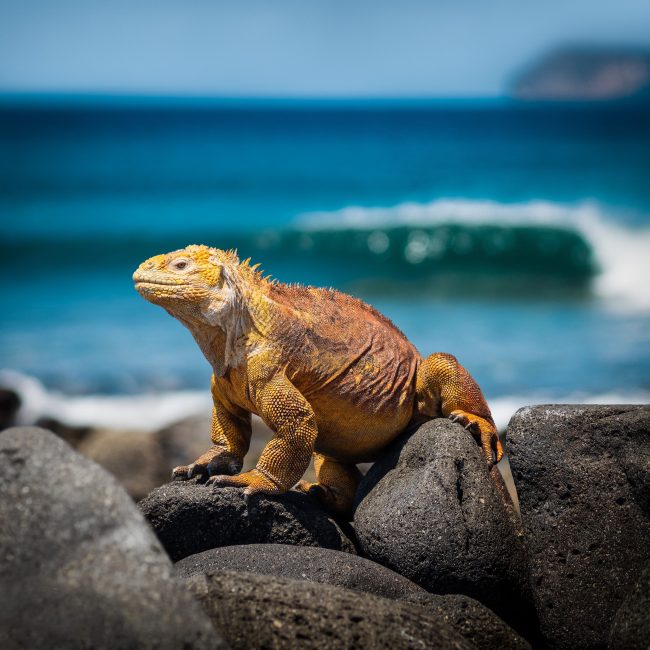
Known as the Jewel of the Andes, Ecuador boasts a national “Good Living Plan” and has established legal rights for nature, so you can marvel at protected ecosystems spanning coastal, jungle, and mountain habitats.
Take a lesson in natural history in the Galapagos Islands, the well-known seat of Darwin’s most famous ideas, a place sure to inspire you as well. The place where Darwin played with his finches and perfected his theories on evolution is now a UNESCO World Heritage Site, and you can book your own private boat and dive in these amazing waters or simply wander the lava rock trials in search of blue-footed boobies.
Ecuador is famous for its ‘Avenue of the Volcanoes’, a string of 14 volcanoes over 15,000 ft in elevation within a line 200 km long. Nowhere else on earth can you find such high, magnificent mountains that are so easily accessible. The Cotopaxi Volcano is one of the most incredible mountains in Ecuador and also one of the tallest active volcanoes in the world. At an incredible 19,347 feet it rises from the Eastern Andes Mountain Range in a perfectly symmetrical conic form that is entirely covered in snow, all at a stone’s throw from Quito. Explore the tropical jungles of the Amazon Oriental or cool off in the Andean highlands – everywhere you turn the culture is rich and the land is beautiful.
We help you fulfill your bucket list!
If you don’t see what you’re looking for, we would love to help create custom solutions and reach out to you!
Country Information
The Government of Ecuador provides coronavirus-related information at this website: https://www.coronavirusecuador.com. The most up to date information can be found on the Ministry’s Twitter account: https://twitter.com/salud_ec.
To receive important updates, U.S. citizens should ensure that they have registered their travel in Ecuador in the Smart Traveler Enrollment Program. Other alerts and messages are also posted here.
Visas for Ecuador are issued on arrival. A traveler needs a passport with a remaining validity period of six months after the date of entry. All visitors must have return/onward tickets and all required documents for their next destination.
Hepatitis A and B, Tetanus, and Typhoid immunizations are advised for all travelers. Information on vaccinations and other health precautions, such as safe food and water precautions and insect bite protection, may be obtained from the CDC’s Internet site at http://www.cdc.gov/travel.
The climate of Ecuador varies by region, mainly due to differences in altitude and latitude. The coastal lowlands to the west of Ecuador are typically warm. These coastal areas are affected by ocean currents and are hot and rainy between January and April. The weather in Quito is consistent with that of a subtropical highland climate. The city has a fairly constant cool climate mainly because of its elevation and proximity to the equator. There are only really two obvious seasons in the city: dry and wet. The dry season (summer) runs from June to September while the wet season (winter) is from October to May.
The country code for Ecuador +593. Most areas within the country will have mobile access and Internet available. However, some areas while trekking may not have mobile access.
The typical electrical current is 120 volts rated at 50Hz. The main plug type used isType A which has two flat blades.
Make two photocopies of valuables such as your passport, tickets, visas and travelers’ cheques. Keep one copy with you in a separate place to the original and leave another copy with someone at home.
Be sure to inform your credit card company as well as your bank you will travel internationally into South America. This will eliminate any credit card holds for fraudulent activity.
Carrying a credit card, an ATM card or a traveler’s check is advisable. However, carrying cash is preferred especially for emergency purchases. The best places to exchange money are normally bureau de change, which are fast, have longer hours and often give slightly better rates than banks. The local currency is the US dollar (USD). Better hotels, lodges, and camps will accept credit cards, however it is advised to have cash on hand when visiting remote areas and villages.
Ecuador’s population is about 65% mestizo (mixed Amerindian and Spanish). About 25% of the remainder are Amerindian; 7% are Spanish or others; and another 3% are black. There are only a few groups of unassimilated Amerindians on the coast, notably the Colorados and Cayapas. The blacks live mainly in Esmeraldas. The Amazon Basin is inhabited by many primitive tribes, including the Jivaros, once famous for their shrunken-head war trophies, and the Aucas, Zaparos, Cofanes, and Secoyas. In the early 1980’s, the tribes were organized in the Federacion Shuar, which seeks to preserve their cultural identities.
The official language of Ecuador is Spanish, and it is the language spoken by the vast majority of Ecuadoreans. In addition, Northern Quechua and other pre-colonial American languages are spoken by 2.3 million.
Religion in Ecuador is an expression of the different cultural heritages in the Ecuadorian culture including the Spanish colonization, the Native Amerindian and the Afro-Ecuadorian. The majority are Catholics and Protestants. There are also small communities of people who are Jewish and Baha’i.
Ecuador is currently a presidential republic.
The economy of Ecuador is based mostly on exports of bananas, oil, shrimp, and gold. Other primary agricultural products and money transfers from nearly a million Ecuadorian immigrants employed abroad make up a large part of the economy. Ecuador is the world’s largest exporter of bananas. After a severe financial crisis, unsustainable economic policy, inflation, and devaluation of the national currency, Ecuador announced its intention to adopt the US dollar as the official currency. Subsequent protests led to the 2000 Ecuadorean coup d’etat. 40% of the population lives below the poverty line. The completion of the second Transandean Oil Pipeline will enable Ecuador to expand oil exports.



